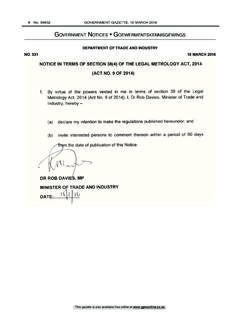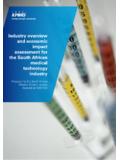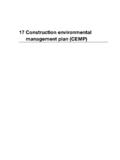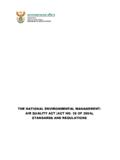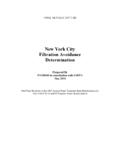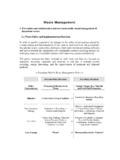Transcription of G N A LGEMENE K ENNISGEWINGS - Samed
1 MS MP MATSOSODIRECTOR- ENE AL: HEALTHDATE: 03 12 (10-3-This gazette is also available free online at No. 39561 GOVERNMENT GAZETTE, 24 DECEMBER 2015 General notices alGemene KennisGewinGsHealth, Department of/ Gesondheid, Departement vanDEPARTMENT OF HEALTHNOTICE 1229 OF 2015 1229 National Health Act (61/2003): National Environmental Health Norms and Standards for Premises and Acceptable Monitoring Standards for Environmental Health Practitioners 395611 NATIONAL HEALTH ACT, 2003 (ACT NO. 61 OF 2003) NATIONAL ENVIRONMENTAL HEALTH NORMS AND STANDARDS FOR PREMISES AND ACCEPTABLE MONITORING STANDARDS FOR ENVIRONMENTAL HEALTH PRACTITIONERS I, Malebona Precious Matsoso, Director-General of Health in terms of Chapter 3, Section 21(2) (b)(ii) of the National Health Act, 2003 (Act No.))
2 61 of 2003) ("the Act") as amended, hereby set National Environmental Health Norms and Standards for premises and acceptable Monitoring Standards for Environmental Health Practitioners for implementation. The National Norms and Standards for Environmental Health is the outcome of a process that is aimed to strengthen the provision of environmental health services in the country. The process included extensive input from Environmental Health Practitioners at District and Metropolitan Municipality, Provincial Departments of Health, Academic Institutions, and other Government Departments. These Norms and Standards are premised on the fact that government recognizes the importance of disease prevention across all levels of health care.
3 The Norms and Standards are therefore essential to strengthen the delivery of Environmental Health Services as a critical programme of preventive and developmental Primary Health Care services. This is also required to make a significant contribution to attainment of the Millennium Development Goals (MDGs), particularly MDGs 4, 5, 6 and 7. The National Norms and Standards for Environmental Health clearly outline monitoring standards for the delivery of quality Environmental Health Services, as well as acceptable standards requirements for surveillance of premises, such as business, state occupied premises, and for prevention of environmental conditions that may constitute a health hazard for protection of public health.
4 This gazette is also available free online at STAATSKOERANT, 24 DESEMBER 2015 No. 39561 52 TABLE OF CONTENTS CHAPTER 1 INTERPRETATION, CONTEXT AND APPLICATION 1. Definitions 2. List of Acronyms 3. Executive Summary 4. Policy and legal context 5. Application 6. Principles CHAPTER 2 NORMS AND STANDARDS FOR ENVRONMENTAL HEALTH SERVICES AND APPLICABLE MONITORING STANDARDS 7. Norms and standards for environmental health services 8. Monitoring standards for Health Surveillance of Premises 9. Monitoring standards for Rodent/Vector Control 10.
5 Monitoring standards for Environmental Pollution Control 11. Monitoring standards for Port Health Services 12. Monitoring standards for Waste Management 13. Monitoring standards for Hazardous Substances Control and Chemical Safety 14. Monitoring standards for Water Quality Monitoring CHAPTER 3 GENERAL PROVISIONS MANAGEMENT AND CONTROL NORMS AND STANDARDS 15. Compliance enforcement 16. Capacity building and training 17. Inter-sectoral collaboration ANNEXURES Annexure A: Norms and standards for premises Annexure B: Standards for water quality on premises Annexure C: Standards for waste management on premises Annexure D: Standards for hazardous substances and chemicals management on premises This gazette is also available free online at No.
6 39561 GOVERNMENT GAZETTE, 24 DECEMBER 20153 APPENDIXES Appendix 1: A framework for designing water quality monitoring programme Appendix 2: List of water related diseases most common in the Southern African region Appendix 3: Guideline Health certificates (A-F) Appendix 4: Guideline for risk assessment in child care centres Appendix 5: Guideline risk assessment tool for child care centers Appendix 6: Guideline for risk classification and profiling in food handling premises Appendix 7: Guideline risk categorization Appendix 8: Guideline risk categorization tool/scoring tool for food handling premises 17. REFERENCES This gazette is also available free online at STAATSKOERANT, 24 DESEMBER 2015 No.
7 39561 74 CHAPTER 1 INTERPRETATION, CONTEXT AND APPLICATION 1. DEFINITION OF TERMS For the purpose of this document, the following definitions apply: Accommodation establishment Means a hotel, guest house, lodge or boarding house, bed and breakfast and any other establishment where accommodation is provided to people on a temporary basis or on a semi-permanent basis; Agricultural remedy Means any chemical substance or biological remedy, or any mixture or combination of any substance or remedy intended or offered to be used for the destruction, control, repelling, attraction or prevention of any undesired microbe, alga, nematode, fungus, insect, plant, vertebrate, invertebrate, or any product thereof, but excluding any chemical substance, biological remedy or other remedy in so far as it is controlled under the Medicines and Related Substances Act, 1965 (Act No.)
8 101 of 1965), or the Hazardous Substances Act, 1973 (Act No. 15 of 1973); or as plant growth regulator, defoliant, desiccant or legume inoculants; Aircraft Means an aircraft making an international voyage; Applicable monitoring standards for Environmental Health Practitioners Means activities and actions that Environmental Health Practitioners are expected to undertake in terms of the Scope of Profession of Environmental Health and relevant health legislation; Approved building plan Refers to a building plan approved by the local authority or approved by the review board on appeal to the review board in terms of the National Building Standards Act, 1977 (Act No.
9 103 of 1977); Authorized EHP Refers to an EHP authorized in terms of Section 8of the Hazardous Substances Act, 1973 (Act No. 15 of 1973); Bait Means a product manufactured with food or other material that pests consume, which often contain an active ingredient that kills the pests; Bait Station Refers to containers used to house bait for pests. Stations vary in appearance depending on type and model; Building waste Means building and demolition waste as defined in the National Environmental Management: Waste Act, 2008 (Act No. 59 of 2008); Bulky waste Means business waste or domestic waste which by virtue of its mass, shape, size or quantity is inconvenient to remove in the routine door to door municipal service provided by the council; Business premises Means premises used for business activities including but not limited to retail, wholesale distribution, import and export; Business waste Means business waste as defined in the National Environmental Management: Waste Act, 2008 (Act No.
10 59 of 2008); Chemical Means a substance whether by itself or in a mixture or preparation and whether manufactured or obtained from nature but doesn t include any living organism; Chemical quality Refers to the nature and concentration of inorganic chemicals, organic chemicals and radioactive substances in the water Chemical safety Means undertaking all activities involving chemicals in such a way to ensure the safety of human health and the environment. It covers all chemicals, natural and manufactured, and full range of exposure situations from the natural presence of chemicals in the environment to their extraction or synthesis and disposal; Chemical waste Means waste which consists of discarded solid, liquid, and gaseous chemicals products that contain dangerous or polluting chemicals that pose a threat to humans, animals or the environment, when improperly deposed; This gazette is also available free online at No.

